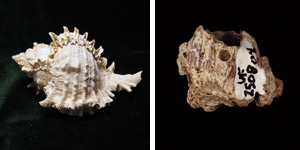By Adiël Klompmaker | FLMNH Post Doc
The Cambrian explosion saw the abundant development of shells in marine animals. The shell’s primary goal? Without a doubt the protection of soft tissue inside it, probably due to increased predation pressures. The fact that a ‘fortress shell’ is not always effective in avoiding predation is already apparent in the Ediacaran, the period before the Cambrian when shells were rare. Some tubular animals already show drill holes, but the culprit is unknown. Drilling predation is also evident in the Paleozoic and Mesozoic albeit at low frequencies. Mean drilling frequencies increased significantly in the Cretaceous and Cenozoic, coincident with the rise of major drilling gastropod groups known to drill today: the muricid and naticid gastropods.

The type of prey commonly studied for drilling predation are mollusks, notably bivalves and gastropods. Their shells preserve well, are easy to collect, and consist only of one or two parts. Although these mollusks were undoubtedly major prey items of drilling predators, research in the last five years has shown that drilling gastropods also preyed upon other animals such as scaphopods, serpulid worms, and even decapod crustaceans and chitons occasionally.
One major prey source, at least for modern muricid gastropods, has hardly been studied from a fossil record perspective. Less than ten articles mention drill holes in fossil barnacles, and often just briefly. We decided to take a look at the invertebrate paleontology collections of the FLMNH. Nearly all of the material originated from the Gulf of Mexico / Caribbean region, including material from Panama.
Spending many days in the collections paid off in the end because every large collection of barnacles studied contained drill holes that can be attributed to gastropods. Two specimens showed drill holes attributable to octopods, animals that still drill barnacles today. Material from the Pleistocene Armuelles Formation of Panama showed gastropod drill holes in several barnacles; a specimen from the Miocene of Panama also showed a drill hole. Drilling frequencies in all examined collections are low (< 10%), indicating that drilling was present, but not extremely common. Modern muricid gastropods also have other means of defeating the barnacle shell, for example by prying apart some of the plates covering the top of the barnacle to gain access to the soft tissue inside the shell. Predation on barnacles is, thus, more common than inferred from drill holes alone.

Gastropods are – oftentimes – smart animals. They tend to drill prey frequently in a location that requires the least energy to penetrate the shell. This certainly applies to drill holes in barnacles. Most of the drill holes are placed between the wall plates where shell thickness is lower, despite the fact that this area occupies only a minor portion of the entire shell. All the drill holes in Panamanian barnacles are placed between the wall plates.
We now have a much better understanding of drilling predation in barnacles in time and space. Drilling in barnacles was already common in at least the Eocene and no major trends in drilling frequencies exist. However, much research should be done on this topic: we have hardly any data from other parts of the world and the effect of barnacle ornamentation on drilling predation is understudied.
Reference
Klompmaker, A.A., R.W. Portell, S.E. Lad, and M. Kowalewski. 2015. The fossil record of drilling predation on barnacles. Palaeogeography, Palaeoclimatology, Palaeoecology 426: 95–111. http://www.sciencedirect.com/science/article/pii/S0031018215001054
Por Adiël Klompmaker | FLMNH Post Doc
La explosión cámbrica vio el abundante desarrollo de conchas en animales marinos. ¿El objetivo principal de la concha? Sin duda alguna, la protección de los tejidos blandos en su interior, probablemente debido al aumento de las presiones de depredación. El hecho de que una “cáscara fortaleza” no siempre es eficaz para evitar la depredación ya es evidente en el Ediácaran, el período anterior al Cámbrico cuando las conchas eran raras. Algunos animales tubulares ya muestran perforaciones, pero el culpable es desconocido. La depredación por perforación también es evidente en el Paleozoico y Mesozoico aunque a bajas frecuencias. La media de frecuencias de perforación aumentó significativamente en el Cretácico y Cenozoico, coincidiendo con el auge de los grupos principales de gasterópodos perforadores conocidos en la actualidad: los gasterópodos murícidos y natícidos.
Los tipos de presas comúnmente estudiados para la depredación por perforación son los moluscos, especialmente los bivalvos y gasterópodos. Sus conchas se preservan bien, son fáciles de recoger y consisten sólo de una o dos piezas. Aunque estos moluscos fueron sin duda las principales presas de los depredadores perforadores, investigaciones de los últimos cinco años han demostrado que los gasterópodos perforadores también tenían como presa a otros animales como cefalópodos, gusanos serpúlidos, e incluso crustáceos decápodos y chitones de vez en cuando.

Una presa importante, al menos para los gasterópodos murícidos modernos, apenas ha sido estudiada desde la perspectiva del registro fósil. Menos de diez artículos mencionan perforaciones en cirrípedos fósiles, y a menudo sólo brevemente. Decidimos mirar las colecciones de paleontología de invertebrados del FLMNH. Casi todo el material provino del Golfo de México y la región del Caribe, incluyendo material de Panamá.
Pasar muchos días en las colecciones dio sus frutos al final porque todas las colecciones grandes de cirrípedos estudiados contenían perforaciones que podían ser atribuidas a gasterópodos. Dos especímenes mostraron agujeros de perforación atribuibles a octópodos, animales que todavía perforan cirrípedos hoy en día. El material de la Formación Armuelles del Pleistoceno de Panamá mostró perforaciones de gasterópodos en varios cirrípedos; un espécimen del Mioceno de Panamá también mostró una perforación. Las frecuencias de perforación en todas las colecciones examinadas son bajas ( < 10%), lo que indica que la perforación estaba presente, pero no era extremadamente común. Los gasterópodos murícidos modernos también tienen otro medio para derrotar la concha del cirrípedo, por ejemplo despedazando algunas de las placas que cubren la parte superior del cirrípedo para ganar acceso al tejido blando en el interior de la cáscara. La depredación de cirrípedos es, por lo tanto, más común que los inferidos a partir de agujeros de perforación únicamente.

Los gasterópodos son – muchas veces – animales inteligentes. Ellos tienden a perforar su presa con frecuencia en un lugar que requiere la menor energía para penetrar en la concha. Esto ciertamente se aplica para hacer perforaciones en los cirrípedos. La mayoría de las perforaciones se sitúan entre las placas donde el grosor de la cáscara es menor, a pesar de que esta zona ocupa sólo una pequeña parte de toda la concha. Todos los huecos en los cirrípedos panameños se colocan entre las placas.
Ahora tenemos un mejor entendimiento de la depredación en cirrípedos en el tiempo y espacio. La perforación en cirrípedos ya era común por lo menos en el Eoceno y no existen grandes tendencias en las frecuencias de perforación. Sin embargo, mucha investigación se debe hacer en este tema: apenas tenemos datos de otras partes del mundo y el efecto de la ornamentación de los cirrípedos en la depredación por perforación está poco estudiada.
Referencia:
Klompmaker, A.A., R.W. Portell, S.E. Lad, and M. Kowalewski. 2015. The fossil record of drilling predation on barnacles. Palaeogeography, Palaeoclimatology, Palaeoecology 426: 95–111. http://www.sciencedirect.com/science/article/pii/S0031018215001054